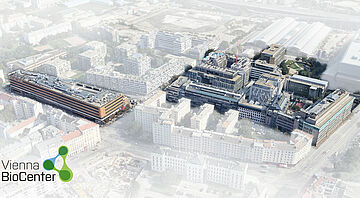
Computational Biology, Genomes and Evolution
How can innovative analyses be used to explore natural variation and uncover novel biological mechanisms?
To understand the vast complexity in biology, many research projects at the Vienna BioCenter have integrated algorithm development, modeling, and high-throughput processing of data. These computational tools enable the next-level analysis of large amounts of biological data, ranging from high-throughput microscopic images to genome sequences or thousands of single-cell transcriptomes, and are also indispensable for evolutionary biology research.

Computational biology has become the common thread that runs through all the Research Areas at the Vienna BioCenter. It involves developing and applying data-analytical and theoretical methods, mathematical modeling, and computational simulations to describe diverse biological functions at different spatial scales. Since the sequencing of the first whole genome in 1995, all major model organisms and hundreds of other species have had their genomes wholly or partially sequenced. This has led to genome-wide analyses becoming commonplace in many research institutions, and groups at the Vienna BioCenter use them extensively to study genomes (including their 3D organization), epigenomes, and transcriptomes. In turn, this has necessitated innovative strategies to process, analyze, and store the resulting datasets. Computational methods are also heavily used in biophysics, structural biology, and imaging at the Vienna BioCenter; for example, molecular dynamics uses computer simulations to model the structure of biomolecules and their interactions with the environment.
Evolution is the unifying theory of the biological sciences: as Theodosius Dobzhansky put it, “nothing in biology makes sense except in the light of evolution”. Various aspects of evolutionary biology research are ongoing at the Vienna BioCenter, with one particular stronghold being the analysis of genomic and epigenomic variants to assess natural variation within and between populations. Such analyses provide insights into complex traits, adaptation, speciation,and evolutionary ecology (e.g., how competition between and within species has evolved). Some groups use comparative genomics to focus on the evolution of specific biological systems, such as biological clocks, hormone systems, or gene regulation.
Finally, the Mathematics and BioSciences Group and the Center for Integrative Bioinformatics Vienna develop mathematical methods and models that mimic the process of evolution.
Research Groups "Computational Biology, Genomes and Evolution"
| Research Group | Institute | Topic |
|---|---|---|
| Berger | GMI | Chromatin Architecture and Function |
| Dolan | GMI | Development and Evolution of Land Plants |
| Mari-Ordonez | GMI | Mechanisms of recognition and silencing of transposons in plants |
| Nordborg | GMI | Population Genetics |
| Ramundo | GMI | Chloroplast biogenesis and protein quality control |
| Swarts | GMI | Tree-ring genomics |
| Brennecke | IMBA | Transposon silencing & heterochromatin formation by small RNAs |
| Burga | IMBA | Molecular determinants of biological idiosyncrasy |
| Elling | IMBA | Functional genomics in embryonic stem cells |
| Gerlich | IMBA | Chromosome structure and dynamics |
| Goloborodko | IMBA | Theoretical Models of Chromosome Structure |
| Jachowicz | IMBA | 'Dark' genome in early mammalian development |
| Rivron | IMBA | Blastoid development and implantation |
| Stark | IMP | Understanding transcriptional regulation |
| Tanaka | IMP | Molecular mechanisms of vertebrate regeneration |
| Campbell | Max Perutz Labs | Mechanisms that ensure chromosome segregation fidelity in mitosis |
| Hein | Max Perutz Labs | Systems Biology & Viruses |
| Hermisson | Max Perutz Labs | Mathematics and BioSciences Group (MaBS) |
| Menche | Max Perutz Labs | Quantitative Modelling of Biological Networks |
| Raible | Max Perutz Labs | Origin and Diversification of Hormone Systems |
| Ries | Max Perutz Labs | Super-resolution microscopy for structural cell biology |
| Swarts | Max Perutz Labs | Tree-ring genomics |
| Tessmar | Max Perutz Labs | Lunar periodicity and inner brain photoreceptors |
| von Haeseler | Max Perutz Labs | CIBIV - Center for Integrative Bioinformatics Vienna |
| Zagrovic | Max Perutz Labs | Molecular Biophysics |
| Baltazar de Lima de Sousa | Uni Vienna - Faculty of Life Sciences | Archaea Genome Evolution and Ecology |
| Golestani | Uni Vienna - Faculty of Life Sciences | Computational Modelling of Brain Function, Experimental Psycholinguistics and Psychophysics |
| Kuhlwilm | Uni Vienna - Faculty of Life Sciences | Evolutionary genomics |
| Mitteroecker | Uni Vienna - Faculty of Life Sciences | Theoretical and Evolutionary Biology |
| Pavlicev | Uni Vienna - Faculty of Life Sciences | Evolvability and Reproductive Biology |
| Revilla-i-Domingo | Uni Vienna - Faculty of Life Sciences | Early Animal Evolution, Stem Cell Differentiation & Deep-Sea Sponge Ecology |
| Rittmann | Uni Vienna - Faculty of Life Sciences | Archaea Physiology & Biotechnology |
| Simakov | Uni Vienna - Faculty of Life Sciences | Evolution of Metazoan Genome Architecture |
| Steiner | Uni Vienna - Faculty of Life Sciences | Mollusk Systematics |
| Technau | Uni Vienna - Faculty of Life Sciences | Molecular Evolution and Development |
| Waldherr | Uni Vienna - Faculty of Life Sciences | Computational Methods for Bio-/Chemical Processes |
| Weckwerth | Uni Vienna - Faculty of Life Sciences | Systems Theory in Ecology and Biology |
| Horn | Uni Vienna - CeMESS | Microbial Symbioses |
| Polz | Uni Vienna - CeMESS | Microbial Population Genomics & Microbial Viruses & Evolutionary Ecology & Microbiomes |
| Rattei | Uni Vienna - CeMESS | Computational and Systems Biology & Genome and Metagenome Analysis & HPC |
| Willemsen | Uni Vienna - CeMESS | Genomic evolution of giant viruses |




